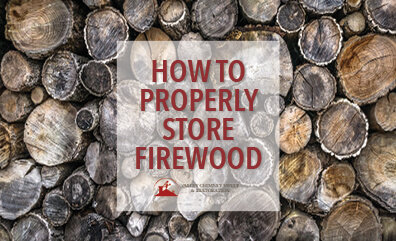
Tips for How to Store Your Firewood

By now if you have a wood burning stove or fireplace, you’ve purchased your supply of firewood for the winter. If you’re a real pro, you actually purchased your unseasoned firewood last year and it’s been seasoning (drying) in your yard all year.
And as long as this isn’t your first winter with a fireplace, you’ve probably developed a system for storing your firewood over the long winter. However, there are some tried and true tips we often offer to our chimney inspection and cleaning customers when we see mistakes in how they’re storing their wood.
Keep firewood off the ground
If at all possible, it’s really important to keep your firewood pile off soil or grass. Ideally, firewood should be dried for at least six months before burning in a fireplace. Storing it on the ground will only make that process longer because moisture from the ground will seep into your pile. If you don’t have a concrete pad upon which to place your wood pile, simply purchase a a couple of pieces of long treated lumber and stack your lumber perpendicular to the pile.
Stack firewood properly for efficient drying time
Before just piling up your firewood in a haphazard fashion, there are a couple of things to keep in mind. First think about which way the wind normally blows at your home. Construct your stack parallel to the wind direction. Doing so creates a natural wind tunnel, which will aid in faster drying times. Also, be sure to stack the wood pieces with a few inches between. Stacking wood too closely together will trap moisture.
Cover your wood pile with a tarp
Any home improvement store has a wide selection of fiberglass tarps you can use to cover your woodpile. We would also recommend some tar paper as an added layer under the tarp. Be sure not to cover your entire pile, though. Doing so will seal in the moisture. You may also consider a tarp with grommets at the corners so that you can stake it into the ground and keep it securely in place.
Create a peak in your woodpile
Be sure to stack the middle of your wood pile a couple of inches higher than the rest. Doing so provides maximum drainage and runoff of any precipitation that may hit your tarp.
Take it indoors
If you have the room indoors, keep a small pile of wood that you plan to use next. This will allow the wood to dry out even more before it hits the fire. There are many decorative options you can use for indoor storage, just make sure to only bring in what you plan to use. Don’t bring unseasoned wood indoors, as it can contain bugs and other critters you don’t want indoors.
Burn only seasoned wood
It’s best to let your firewood dry or “season” for at least six months before burning it. Seasoned firewood can be purchased, but is twice as expensive as unseasoned wood. If you plan on seasoning your own wood, make sure to employ our steps above and know the signs of wood that is ready to burn, including: cracks in the center and bark that is easily removed from the log.
ALSO READ : Why You Shouldn’t Burn Unseasoned Wood in Your Fireplace
Chicago’s Best Chimney Sweep
As the Chicago area’s highest rated Chimney Sweep, the team at Valley Chimney Sweep & Restoration, recommend a thorough inspection and cleaning before lighting your first fire of the season. There are many unseen dangers in lighting a fire without a properly cleaned chimney. Contact us today to schedule your inspection!
Back To Blog

